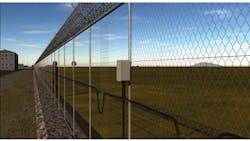Perimeter intrusion detection: The first line of defense
When it comes to the topic of perimeter security, the lines of definition become a bit blurred as you consider the colliding worlds of network and physical security. In the IT universe, perimeter security defines the vulnerable endpoints hackers look to penetrate an organization’s network. For physical security practitioners, perimeter security is about as basic a concept as there is.
A holistic approach to outdoor physical perimeter security is one that determines a facility’s first line of defense where technology is designed to deter, detect, delay and deny entry. The concept that is commonly referred to as “Concentric Circles of Protection,” involves the use of multiple “rings” or “layers” of security. The first layer is located at the boundary of the site, and additional layers are provided as you move inward through the building toward the high-value assets.
It may be a basic concept, but the advanced technology that characterizes end user’s options is as varied as they are unique.
The same data gathering and analytics that are driving both video surveillance and access control are also providing the foundation for some of the most unique and compelling technologies being developed for the Perimeter Intrusion Detection System (PIDS) and barrier protection marketplace.
Recent technology evolutions and trends are having a direct impact on the performance and evolution of PIDS systems. These include developments in signal processing, artificial intelligence (AI), machine learning, data analytics, as well as improvements in computing technologies and their processing power. By leveraging some of these new technologies and developments, the quality, reliability, and performance of PIDS sensors can be greatly enhanced, according to Erick Reynolds, PSP, who is Vice President of the Americas for Future Fibre Technologies (FFT). Future Fibre Technologies is a fiber optic sensing technologies company based in Melbourne, Australia, with its U.S. headquarters in Mountain View, California.
“The most important performance measure of any PIDS system is its ability to maintain a high probability of detection (POD) to intrusions while minimizing alarms due to nuisance events, in particular, those caused by wind, rain, traffic or other nuisance activities. Simply increasing sensitivity to increase POD also increases sensitivity to nuisance events. To tip the scales in favor of POD, intelligent and advanced algorithms are required so that the PIDS system can adapt to different environments and intelligently discriminate between intrusions and nuisances. The ability to automatically adapt to changing conditions is a particularly important feature as it reduces the need for periodic tuning of the system,” says Reynolds. “Recent advances in AI and other related intelligent signal and data processing techniques are being leveraged to make Fibre Optic Cable PIDS systems more intelligent. State-of-the-art computer hardware with ever-increasing processing power has enhanced the capability of high-end PIDS systems such as COTDR-based sensors where a very large volume of data needs to be processed and analyzed in real-time.”
The integration and layering of different PIDS-related technologies continue to offer customers the most dramatic improvements to site security. The benefits are clear: combining cost-effective technologies can reduce nuisance alarms while leveraging their individual strengths, relates Stewart Dewar, Product Manager for PIDS Solutions at Senstar, a global provider of PID VMS solutions for more than three decades.
“For example, we recently protected the perimeter of a large midwestern airport using buried RF cable and fence-mounted fiber-optic sensors working in cooperation. A key customer concern was the potential for a high rate of nuisance alarms generated by nearby foot traffic and public transportation. The deployed system maintains its high vulnerability to defeat while rejecting potential alarms generated by innocent perimeter disturbances (e.g. leaning on a fence while waiting for a bus).
“Another technology combination that is receiving a lot of attention is the augmentation of physical PIDS sensors with video analytics. Advances in hardware and software have improved video analytic capabilities while lowering its cost, making the technology available to previously under-served customers,” explains Dewar. “In these scenarios, PIDS sensors remain the primary means to detect potential intrusions, while video analytics enhance and characterize intrusion detection. For example, people and vehicle tracking can improve tracking and classification accuracy, Auto PTZ improves surveillance coverage while reducing security personnel resources, and license plate recognition enables the whitelisting/blacklisting of vehicles at a site.”
Maira Zanrosso, the Director of Sales and Marketing at Southwest Microwave, Inc., insists that while cybersecurity is, and certainly should be, a top security industry concern given the evolving dependence on networked solutions, PID systems remain the first line of defense in most enterprise operations.
“While cybersecurity now tends to be at the forefront of the security system discussion, physical security systems, and more specifically perimeter security, has also become essential in protecting today’s critical assets and key resources. Overall, security requirements are trending towards tighter controls with nationally regulated security standards that integrate detection, assessment and response technologies,” she says. “Unfortunately, there is limited flexibility within IT infrastructure for these third-party equipment connections to access secure networks. As such, PIDS technology is having to evolve to not only provide a higher probability of detection with lower nuisance alarm rates but also greater adaptability to achieve both systems isolation and integration.”
FFT’s Reynolds adds that another growing trend for PID systems is their ability to protect longer perimeters from a single controller, which helps to reduce the overall capital investment of an organization. He cites as an example the latest generation of his company’s product which is the two-channel Aura Ai-2 that can cover 37 miles with 30km per channel (18.5m) with pinpoint location accuracy (+/- 1m to 4m). The controller can also cut redundancy.
“As the cost to protect extended perimeters falls then the industry should be pushing out the first layers of security to increase standoff distances and increase warning times of a potential security breach. Secondary verification can still be achieved by supporting CCTV cameras or drones,” says Reynolds.
Perhaps no technology is being viewed under a more intense spotlight than PID systems because of the current administration’s concerns related to border and critical infrastructure security. As the on again, off again talks of building a “wall” to protect the nation’s southern border continue, practicality and budget realities dictate more reliance on technology than concrete.
“As the world’s security situation remains unstable and we are witnessing a significant increase in the number of perimeter intrusions, organizations are becoming more threat aware leading to an increase in the demand for solutions to mitigate operational risk,” contends Reynolds. “One of the biggest challenges for the critical infrastructure and border security sectors is to provide a cost-effective perimeter security system that is capable of protecting a long border or large infrastructure site, and reliably detecting and reporting the accurate location of intrusions to the end-user while dealing with the complexities of associated activities and environments specific to the site. This requires the processing and real-time analysis of complex and large volumes of data or signals from different sensors and technologies, and needs to be done in the context of a multi-layered security solution.”
Dewar agrees that the critical infrastructure market, especially the energy sector, continues to be an area of intense focus with respect to physical security and feels that for perimeter security companies, this means working with customers to help them meet current and proposed regulatory security requirements.
“For example, the North American Electric Reliability Corporation (NERC) requires that all bulk power providers comply with Critical Infrastructure Protection (CIP) reliability standards. Perimeter security is a key element for the protection of critical assets, and providers are looking for innovative solutions that can address their security concerns, especially for sites which may be remotely located or unmanned," Dewar says.
He adds that there is a renewed interested in buried fiber optic sensing technologies for border protection to help officials detect illegal crossings both above and below ground. Border areas, especially those in North America, require sensors that are both convert and support sensing over extremely long distances.
Protecting critical infrastructure and borders worldwide has been a primary focus for Southwest Microwave since the introduction of its technologies in 1971 points out Zanrosso.
“As threats to these assets have become more sophisticated and widespread, we have seen commensurate industry-wide growth in PIDS innovation and technology options. For a user investing high dollars in protecting these key resources, filtering through a maze of choices to arrive at the optimal solution can pose a tremendous challenge.
“To maximize value for our customers, we take a multi-pronged approach to critical infrastructure risk mitigation: Investment in aggressive research and development to deliver detection technologies with unique digital tuning capabilities that maximize detection probability and nuisance alarm prevention. Focus on the supply of user-friendly, flexible software-driven intelligent sensors so as to keep system training, implementation and change costs low, reducing total cost of system ownership. Lastly, a continued nurturing of technology partnerships to ensure ease of integration and system interoperability as layered protection becomes the norm for a high-security environment,” concludes Zanrosso.
Building an effective PID system requires an open technologies concept says Senstar’s Dewar, emphasizing that for a security system to benefit from multiple-technology coordination, standard integration interfaces are the key.
“By adopting open standards, platforms and communication mechanisms, we provide end-users, A&Es, and integrators with different options, letting them choose what is best for the end-users. We are also a member of the Open Network Video Interface Forum (ONVIF) and support the development and adoption of open standards for IP video devices and software,” says Dewar, who also touts his company’s hands-on relationship with its clients. “A major part of our customer focus is listening to their requirements and offering products that meet their needs, both in terms of perimeter security itself and ease of deployment. This may involve designing perimeter sensors that avoid expensive infrastructure requirements or by dramatically reducing customer operating costs.”
Reynolds says the FFT approach also dictates a multiplicity of technologies that can expand the capabilities of a seamlessly integrated system to include over 50 third-party solution providers.
“When it comes to securing a perimeter, there is no single technology that will provide the complete solution. A perimeter intrusion detection system is only a single piece of a larger security program and solution. The key to securing perimeters is to use a multi-layered approach that includes a combination of a physical barrier (fence), CCTV cameras, access control, and perimeter intrusion detection,” he stresses.
About the Author:
Steve Lasky is the Editorial Director of SouthComm Security Media, which includes print publications Security Technology Executive, Security Dealer & Integrator, Locksmith Ledger Int’l and the world’s most trafficked security web portal SecurityInfoWatch.com. He is a 30-year veteran of the security industry and a 27-year member of ASIS.
About the Author
Steve Lasky
Editorial Director, Editor-in-Chief/Security Technology Executive
Steve Lasky is Editorial Director of the Endeavor Business Media Security Group, which includes SecurityInfoWatch.com, as well as Security Business, Security Technology Executive, and Locksmith Ledger magazines. He is also the host of the SecurityDNA podcast series. Reach him at [email protected].

